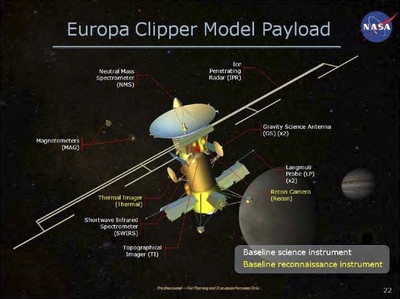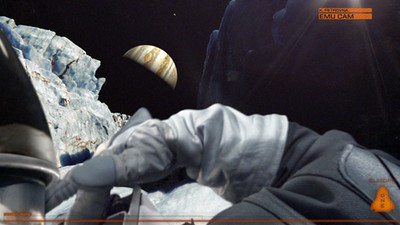Talk of an icy moon at Vegas for Nerdsby Dwayne Day
|
| Producer Ben Browning said that his motivation was actually to produce a movie about what first contact with alien life might actually be like. That led to Europa as the focal point. |
Plait is an enthusiastic speaker, but has two vital traits as a moderator that make him superior to many of the moderators at Comic Con: he comes prepared with questions for his panelists, and he listens to what they say and is therefore able to follow up on their comments. He opened the discussion by noting that there are essentially three reasons why we explore: resources, danger, and simply to discover and see what is out there. That is true both for past exploration of the Earth as well as for space exploration today.
Director Sebastian Cordero explained that he was brought onto the production after a script had been developed and he didn’t know anything about Europa. He did not do any research before reading the script, and was impressed at how the script was based upon actual science and technology. He said that he was particularly inspired by the Al Reinert documentary For All Mankind, about the Apollo missions.
Producer Ben Browning said that his motivation was actually to produce a movie about what first contact with alien life might actually be like. That led to Europa as the focal point. Because they lacked budget, they decided to film the movie as “found footage,” which meant all the work was on a soundstage using fixed cameras. They built an enclosed spacecraft set in Brooklyn with multiple cameras inside and Cordero directed from outside the set using audio commands for his actors. This resulted in a large amount of footage because scenes were often filmed with more than one camera. That then enabled them to assemble the story during the editing process, emphasizing certain views and storylines by picking the footage.
Plait provided a little bit of explanation about Europa itself. It was first discovered by Galileo, and the “Galilean moons” of Jupiter were the first positive proof of objects circling another body in the solar system—which created a bit of a controversy between Galileo and the Catholic Church. Plait noted that Europa is the first solar system body discovered other than Earth that may have liquid water. Indeed, the water under the ice on Europa is far greater than all the water on Earth.
Composer Bear McCreary discussed the soundtrack for the film. I am a huge fan of McCreary, own many of his albums, have seen him perform in concert, and have heard him speak at several conventions, most recently at Galacticon. McCreary is a formally trained composer who understands musical theory and often incorporates a broad range of instruments into his work. He is incredibly talented and has an amazing breadth. He also comes across as somebody who loves his work and is enthusiastic about his compositions.
| Plait said that although people think that scientists are frequently enraged by how inaccurately science is portrayed on film, what really annoys them is how scientists are portrayed. |
McCreary explained that scoring Europa Report was difficult, and that he had developed several different approaches to the music and had to abandon all of them while trying to figure out what kind of music should accompany what purports to be a documentary of a human space mission. He said that he achieved a conceptual breakthrough when he started to think of himself as the composer hired by the fictional corporation behind the space mission—and its ostensible documentary. How would that company want to score the documentary? The documentary would be their attempt to put a positive spin on a mission that had gone very badly. Once he realized that, he managed to develop two themes for the soundtrack, one more atmospheric and the other a more traditional melody. The soundtrack album is due out soon.
Plait said that although people think that scientists are frequently enraged by how inaccurately science is portrayed on film, what really annoys them is how scientists are portrayed. Europa Report, Plait said, gets scientists right. Scientists are fascinated by their subjects of study, and in the movie they take dangerous risks so that they can collect data that they think is important.
JPL scientists Steve Vance and Kevin Hand were also on the panel and discussed their roles as science advisers. As Plait explained, often science advisers are brought onto a science fiction production to provide a thin veneer of scientific plausibility to what is above all entertainment, and scientific accuracy is not allowed to get in the way of the drama. But Vance and Hand had a significant role in developing the story and ensuring that it was not outside the bounds of reality, and in fact sometimes making the drama out of the scientific reality. Hand also added that he thought that the characters and the drama were quite good, making the movie interesting. Europa Report isn’t a science documentary.
Cordero provided an example of the science actually leading to a change in the story. Originally, the third act of the script had a key event happening on the surface of Europa. But Vance and Hand explained that this was not really plausible, but had to happen under the ice—where the action is. So they found a way to rewrite the story so that the action could happen under the ice, and Cordero said that the change actually made the story more dramatic, in addition to being scientifically accurate. Without giving it away, they were effective.
 The best shot for exploring Europa in the foreseeable future is not with a human mission but a robotic probe like the proposed Europa Clipper. (credit: NASA) |
Browning added that Vance and Hand had emphasized how dangerous the radiation at Europa is, and this allowed screenplay writer Philip Gelatt to integrate that into the plot. When a character leaves the lander, they face the brutal radiation caused by Jupiter’s magnetic field picking up particles, accelerating them, and slamming them down into the moon’s surface. Although they did not mention it, there is a great minor plot point that demonstrates the scientific accuracy of the mission: a character mentions that the Europa lander is surrounded by a water shield to protect it from the radiation, and of course carrying all this water with them makes their lander quite heavy.
| Vance and Hand had a significant role in developing the story and ensuring that it was not outside the bounds of reality, and in fact sometimes making the drama out of the scientific reality. |
Karolina Wydra played one of the scientists onboard the Europa mission. She said she read Mary Roach’s book Packing for Mars before starting filming, and found it very informative (see “Review: Packing for Mars”, The Space Review, August 16, 2010). She also talked to a marine biologist about her work and was impressed how passionate the scientist was about her research. She said that the cast rehearsed extensively before filming (something that was probably necessitated by the closed-set filming method). She had to wear a 50-pound spacesuit for a crucial scene and found that she could only wear it for short stretches before having to take a break. Her character is passionate about her scientific research, so much so that she takes extreme risks, and pays for it.
Vance and Hand explained that we are still a long way from sending humans to Europa. JPL has been studying a mission called the Europa Clipper that would fly past Europa and help characterize its surface. As somebody who knows a lot about the policies and politics of planetary science, I was acutely tuned in for any statements that might create false impressions that Europa missions are in the near future. Vance and Hand did a pretty good job of managing expectations while not squashing the hopes of the audience that someday we will explore Europa in the way that it truly deserves, hopefully not as tragically as in Europa Report.
